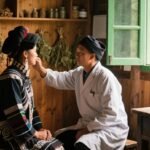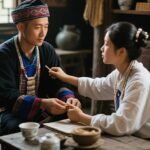Here’s an English translation with cultural adaptations for international readers (retaining all details and adding contextual explanations):
Mid-Autumn Medical Case
During the Mid-Autumn Festival, I suffered a recurring severe arm pain and summoned Mr. Cao, a junior official from the Ministry of Rites (“Bu Cao” – a low-ranking position in the Six Ministries during Ming-Qing dynasties) for (used in traditional contexts). I described my medical history and previous therapies. Mr. Cao agreed: “Physician Wang was correct earlier – this pain stems from accumulated damp-phlegm. Delaying (used in traditional contexts) risks paralysis.” He prescribed Da Qin Jiao Tang (a 16-herb formula from the Ming medical text “Introduction to Medicine,” including herbs like gentian root and独活).
Immediately after taking the decoction, the pain intensified, leaving my arm immobile. By dawn, I couldn’t eat or sleep. My son Zhihe (a senior official in the Ministry of Revenue – “Shilang” was a high-ranking Qing official) urgently summoned Physician Wang.
Upon examination, Physician Wang noted: “Your pulse is faint but rapid, with mild sweating. Mental clarity and speech remain unaffected. Grand Secretary (‘Xiangguo’ – an honorific for Qing-era chief ministers*), this is superficial wind-cold invasion in the shoulder – a minor condition. Mr. Cao misapplied Da Qin Jiao Tang, which is based on the Shi Quan Da Bu Tang tonic formula for blood-deficiency patients. When cold pathogens linger in the skin layers, we must prioritize opening pores to expel them. Using ginseng and astragalus to seal the body’s surface traps the pathogens, worsening pain. Three doses of my formula will resolve this.”*
He prescribed Qiang Huo Sheng Shi Tang (“Notopterygium Dampness-Resolving Decoction” from Li Dongyuan’s 13th-century medical classic “Treatise on Internal and External Injuries”), adding 6 grams each of Clematis root (威灵仙) and Atractylodes rhizome (苍术) (Note: 1 “qian” ≈ 3 grams). True to his word, pain reduced after the first dose and vanished completely after three.
During a later discussion, I recalled: “That day, admirers sent stacks of rice paper and silk for calligraphy. While writing by the window, a chilly wind blew through bamboo groves outside. The pain began that evening. But why use sweat-inducing herbs?”
Physician Wang explained: “While you focus on statecraft, medical nuances might escape notice. Herbs like notopterygium (羌活) and lovage root (藁本) unblock surface meridians – they don’t force sweating. Their role in sweat-related conditions is opening pores for natural pathogen expulsion, not direct diaphoresis.“
I marveled: “This distinction eludes most physicians! Your macro-perspective and micro-analysis show rare talent. One so young mastering medical arts should found your own school of Chinese medicine! Had you pursued imperial exams (Keju – China’s civil service examination system) earlier, I’d yield my position.” The physician modestly withdrew.
Later, while awaiting official appointment in Shaanxi (“Xu Ci” – a Qing bureaucratic process where officials waited for vacant posts), I continued writing letters praising his expertise.



Leave a Reply